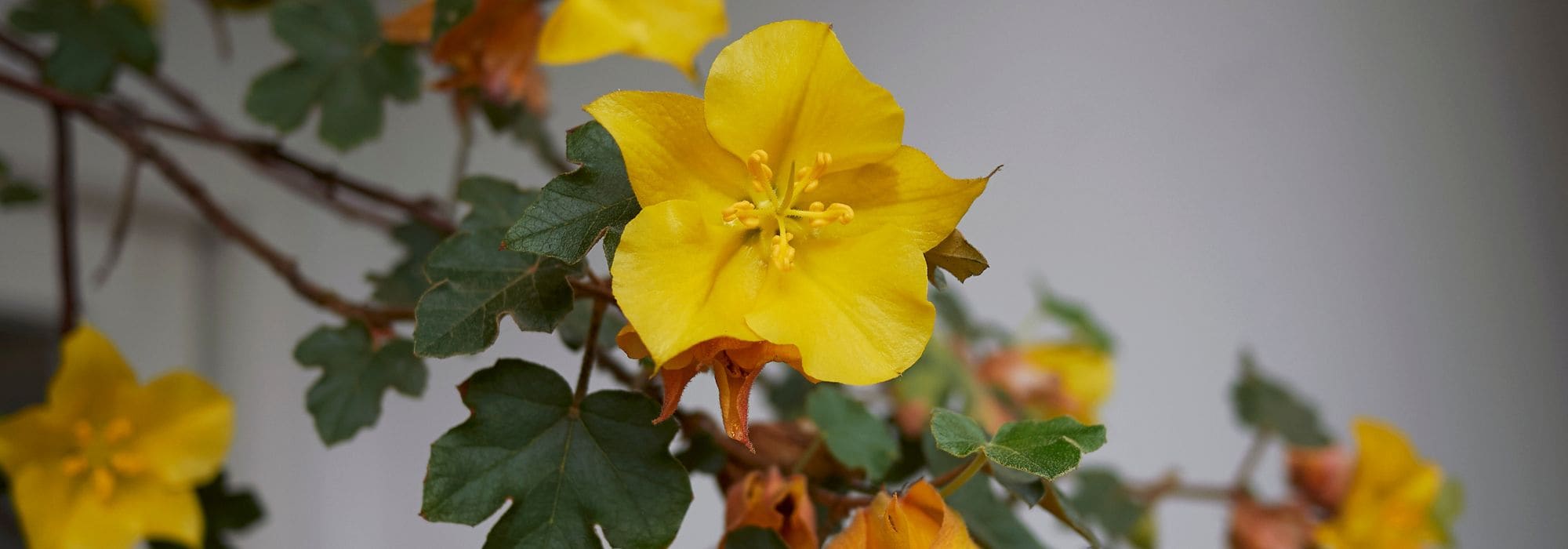
Fremontodendron: planting, pruning and care
Contents
Fremontodendron in a few words
- The Fremontodendron is a woody bush particularly attractive for its golden-yellow flowering.
- It is ideal when trained against a south or south-west-facing wall.
- Native to North America, particularly California and Arizona, it has a hardiness of up to -12°C.
- Resistant to sea spray and winds, it thrives in regions with a mild climate, such as southern France and Brittany.
- This is a full-sun bush that prefers poor, sandy, neutral, or alkaline soil.
The word from our expert
Still rare in cultivation, the Fremontodendron, also known as Fremontia or Fremont’s bush, is an evergreen bush, particularly remarkable and interesting for its golden-yellow flowering. A colour that can only brighten a garden or courtyard. Although not a climbing plant, the Fremontodendron thrives along a wall, warmed by the sun. Equipped with sarmentous stems without an attachment system, the Fremontodendron will need to be trained as it grows relatively quickly. Without a trellis, it behaves like a bush that requires regular pruning to maintain a compact habit. This is, in fact, how it is often cultivated in North America, along roadsides and highways.
A plant from the Sterculiaceae family (or Malvaceae, depending on the classification), the Fremontodendron comprises only two main species: the highly floriferous Fremontodendron californicum, which offers lemon-yellow flowers throughout the summer, and the Fremontodendron mexicanum, with orange flowers, or rather yellow shaded with red. A few hybrids and cultivars have emerged from the cross-breeding of these two species. As for Fremontodendron californicum decumbens, it has a prostrate habit and a smaller size. For the Fremontia is a bush that can reach 3 to 5 m.
A lover of full sun, indifferent to winds and sea spray, the Fremontodendron is moderately hardy, down to -10 to -12°C. This is why it thrives so well along Mediterranean and Atlantic coastlines, particularly in Brittany. However, it should be protected in winter with a good mulch and, if necessary, a winter fleece in case of frost.

The Fremontodendron is a highly floriferous bush
Botany
Botanical data
- Latin name Fremontodendron
- Family Sterculiaceae (or Malvaceae)
- Common name California fremontia, Fremont's tree
- Flowering from April-May to July, and in September-October
- Height 3 to 5 m
- Exposure Sun
- Soil type light, sandy, calcareous, poor
- Hardiness Down to -10 to -12°C
The Fremontodendron is a semi-woody bush native to North America, particularly the warm states of California and Arizona. Due to its robustness and resistance to drought and air pollution, it is often planted along roadsides and highways with heavy traffic. It also grows naturally on slopes, scrub vegetation, and maquis… Needless to say, it is not very demanding in the right climate.
Named Fremontia or Fremont’s tree, this bush is classified either in the Sterculiaceae family or, more rarely, in the Malvaceae family. In any case, it owes its name to the American general John Charles Frémont (1813-1890), who was the first Republican Party candidate for the presidency of the United States. A staunch opponent of slavery, he was also a great explorer of the American West. During these expeditions, as a passionate botanist, he catalogued and harvested many plants, including the Fremontodendron, which pays homage to him.
The genus Fremontodendron includes only two species, the Fremontodendron californicum, the most widely cultivated, and the Fremontodendron mexicanum, native to northwestern Mexico, listed among the endangered species in California. The latter boasts an orange-yellow flowering.
This evergreen bush can reach a height of 2 to 5 m with a spread of 2 to 3 m in our latitudes. In its natural habitat, it can grow up to 9 m tall. With fairly rapid growth, the Fremontodendron has semi-woody shoots that arch easily to climb if provided with support against a wall. Lacking an attachment system (thorns, suckers, tendrils…) like most climbing plants, the Fremontodendron will need to be trained as it grows, for example using stretched wires. If not guided against a wall, it can be treated as a bush, provided it is pruned back in the early years to encourage branching and a more compact, upright habit. These shoots are covered with scaly bark ranging from greyish to dark brown.
The Fremontodendron has evergreen foliage, usually dark green on the upper side and light green underneath. The leaves, palmatilobate and alternate, visually resembling those of the vine, take on a light brown colour underneath due to the hairs covering them. They measure 5 to 7 cm in diameter. The petiole is also pubescent, as are the young stems.
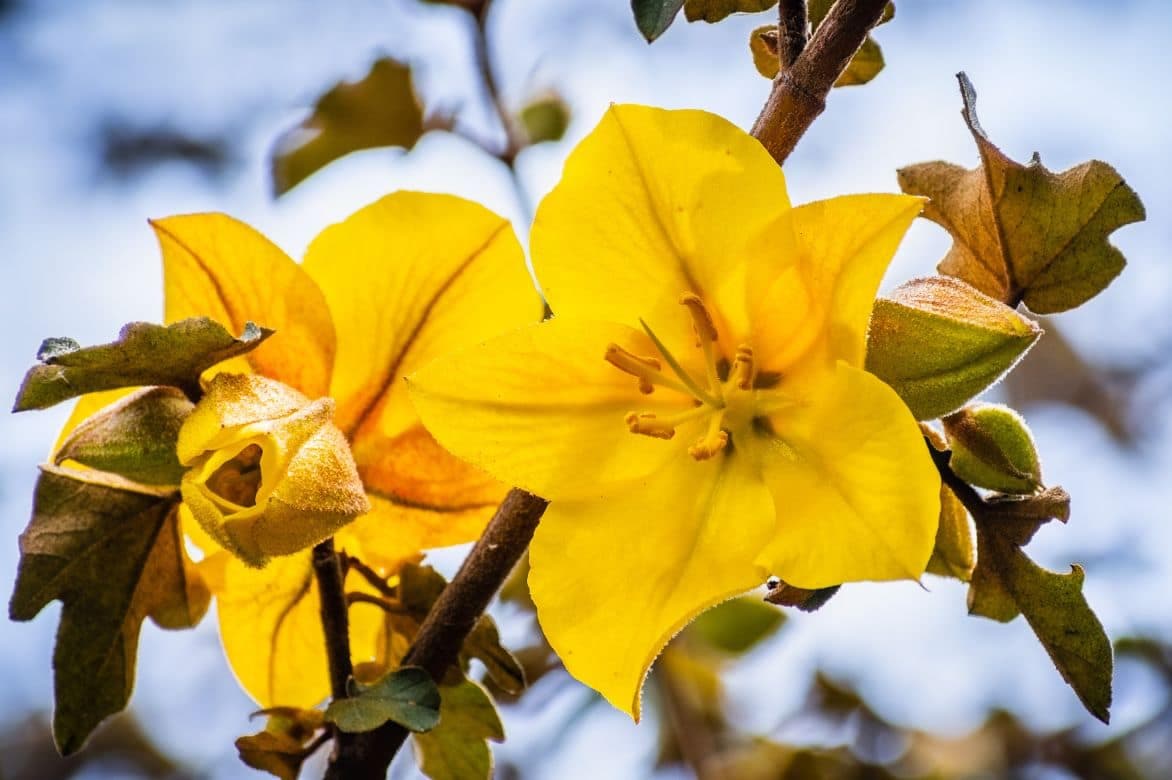
The undersides of the leaves and the flower buds of the Fremontodendron are irritating
As for the flowering, it is attractive for its beautiful golden-yellow colour, which brightens up gardens with its luminosity and brilliance. The flowers, emerging from ovoid and downy flower buds, are solitary and axillary. They form a flat cup 4 to 6 cm in diameter. They feature 5 large obovate sepals, shiny and waxy in appearance, rather rounded with a pointed tip that overlaps. 5 yellow stamens with slightly darker anthers emerge from the centre of the flower. The flowers typically bloom from April-May to July. In regions with mild climates, they may reappear in September and October. Particularly melliferous and nectariferous, these bright yellow flowers invite swarms of insects to feast on nectar and pollen. They are also delicately fragrant.
The flowers give rise to fruits in the form of downy capsules filled with black seeds. These fruits are nestled within the sepals.
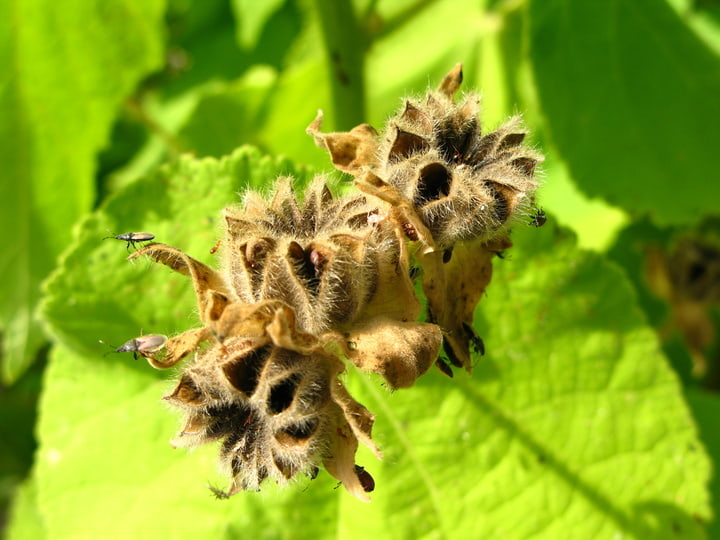
The seed capsules of the Fremontodendron
It should be noted that the hairs covering the foliage, flower buds, and young shoots can cause skin, eye, and respiratory irritation, as well as contact dermatitis. When pruning the Fremontodendron, it is therefore obligatory to wear gloves and long-sleeved clothing.
Our favourite varieties
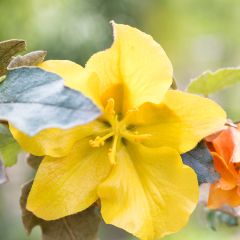
Fremontodendron californicum
- Mois de floraison July, August
- Hauteur à maturité 6 m
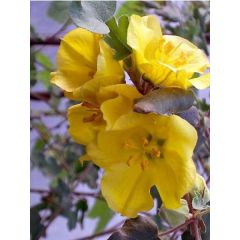
Frémontodendron 'California Glory'
- Mois de floraison June to November
- Hauteur à maturité 6 m
Planting
Where to Plant Fremontodendron?
Due to the irritating nature of its leaves, young shoots, and flower buds, it is advisable to plant Fremontodendron in a location away from daily foot traffic. Similarly, children should be kept at a distance from this otherwise easy-going bush.
Ideally, if you wish to train it, position it against a south or south-west-facing wall or fence. Here, it will benefit from the full sun necessary for its growth. Additionally, its bright yellow flowering will appear even more luminous. You will need to install a sturdy support system on the wall, made of wire and hooks. If you prefer to grow it as a bush, it can be planted at the back of a flower bed or as a standalone feature to fully showcase its golden-yellow flowering. Fremontodendron can also be grown in pots or containers on a large balcony, terrace, or patio. Wherever it is planted, it must be sheltered from the coldest winds.
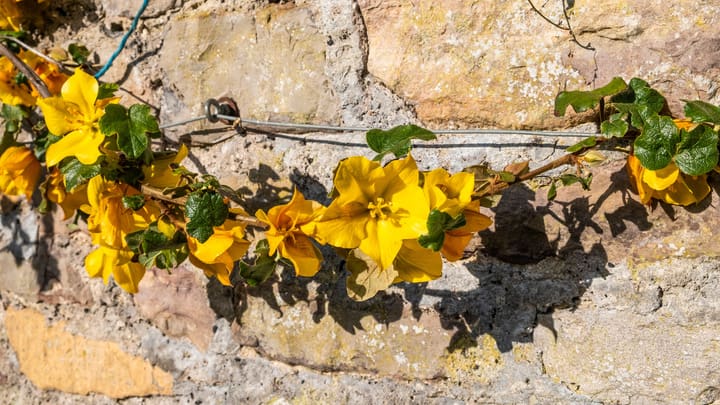
A trained Fremontodendron
It will require light, ordinary, neutral, or alkaline soil, which can be poor, sandy, or even stony. The key is that it must be perfectly drained, as Fremontodendron particularly dislikes stagnant moisture in winter, which can cause its roots to rot.
Fremontodendron is highly resistant to drought once established and can tolerate coastal conditions. Moreover, it has relatively low hardiness. This is why it thrives particularly well along the Mediterranean coast and the Atlantic seaboard. Brittany combines all the ideal conditions.
When to Plant Fremontodendron?
Fremontodendron is best planted in spring, between April and May, to allow it time to establish roots before winter.
How to Plant Fremontodendron?
- Prepare the soil by loosening it well
- Soak the root ball for a quarter of an hour in a bucket of water to ease removal from the pot
- Dig a hole twice the size of the root ball
- Place a layer of gravel at the bottom of the hole to ensure drainage
- Position the Fremontodendron in the hole
- Optionally, add some compost to the excavated soil and fill the hole
- Firm the soil and water generously.
Growing in pots is not necessarily easy but is possible. You will need to provide your Fremontodendron with a wide, perforated pot (at least 50 cm in diameter) or a large container, drained with a good layer of gravel and filled with compost and sand in equal parts.
Maintenance and pruning
Once planted, the Fremontodendron requires no particular maintenance, being drought-resistant as it is. It is even advisable not to water it at all and to keep it away from automatic watering systems or downspouts. However, for the first two years, it will be necessary to provide it with a little water, especially during the flowering period, but without excess to avoid drowning the root system.
A bit sensitive to cold, the Fremontodendron may need a good mulching to protect it from the cold. Similarly, a winter fleece cover can be installed if frost is forecast.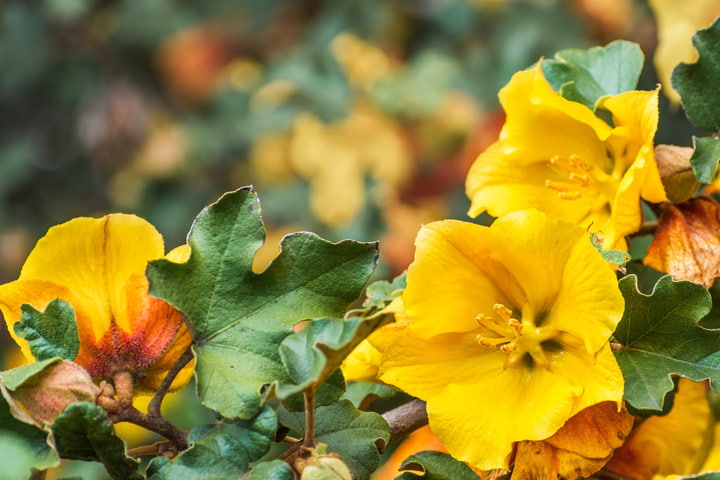
If the Fremontodendron is trained, it is essential to tie the branches as they grow. On the other hand, pruning is unnecessary, though you can remove damaged or dead branches. If grown as a bush, pruning becomes crucial to encourage ramification from the base. This pruning takes place after flowering, around September. Don’t forget your gloves and long sleeves during this task.
→ Learn more with our tutorial: How to train and prune the Fremontodendron?
The Fremontodendron is not susceptible to any parasites or diseases.
Propagation: by cuttings and sowing
With a relatively short lifespan, the Fremontodendron will need to be propagated to ensure its longevity. Two methods, more or less random, are possible.
Propagation by cuttings from stems
This propagation by semi-hardwood cuttings is done in summer, between July and September.
- Prepare pots filled with light compost and sand
- Take semi-hardwood cuttings, i.e., shoots from the current year, without flowers, 15 cm long
- Remove the lower leaves and keep only two
- Plant the cuttings in the substrate
- Firm with your fingers and water lightly without soaking the substrate
- Place the pots outdoors in the shade.
In October, the cuttings are placed under a cold frame. In spring, the cuttings will be planted in buckets to spend a year there. They will be planted in the ground the following spring.
Sowing seeds
- Harvest the seeds contained in the capsules at the end of flowering, i.e., between September and October
- Store them in the refrigerator or in sand outdoors
- In spring, fill buckets with a mixture of special sowing compost and sand
- Soak the seeds in water for 24 hours
- Place the seeds on the surface and cover with a layer of sieved compost
- Mist
- Place the buckets in a room at 19 °C
The substrate should remain moist but not waterlogged.
Uses and associations
Fremontodendron is an easy-to-train bush, perfect for climbing along a brick wall or a wooden fence. Its yellow flowering will create a stunning effect. It pairs beautifully with perennial plants featuring mauve or violet flowers, planted at its base. Fremontodendron complements lavender, Siberian irises, and thyme, all of which thrive under similar growing conditions. You could also plant an Pittosporum tenuifolium with yellow-green foliage, such as ‘Gold Star’ or ‘Golden Ball’.
For more pairing ideas, check out Éric’s article: pairing Fremontodendron.
- Subscribe!
- Contents































Comments